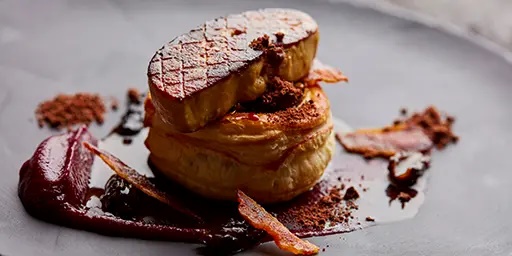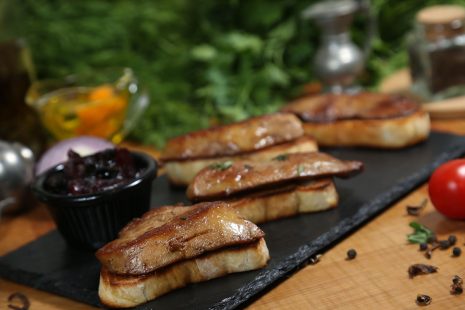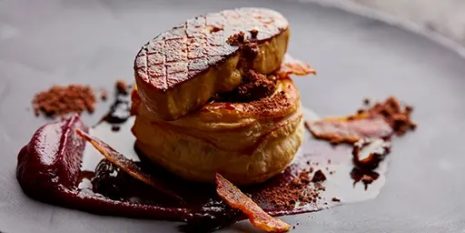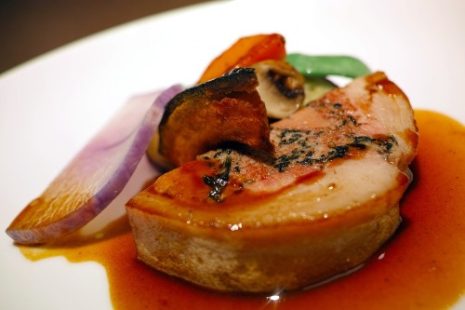
Perfect Pan-Seared Foie Gras
For most of us, a good day ends with a great meal. Whether you’re a chef or just a lover of good food, you’ll know that the best ingredients are everything.
And if you’re looking for a starter or main of the highest luxury, what could be better than perfectly pan-seared foie gras?
Due to its acclaimed reputation and price point, cooking foie gras at home may sound a little intimidating to some, but by following our step-by-step guide and recommendations, you’ll find it’s actually much simpler than it sounds.
What is Foie Gras?
Foie gras is a delicacy made from the fattened liver of a goose or duck (the translation of foie gras is literally “fat liver”) and is renowned for its buttery flavour and smooth texture. Popular in France, it is considered the ultimate pâté, but is also used in terrines, pies, canapés, and more. Besides serving it as a pâté, you can get fresh or frozen foie gras as whole pieces of liver, made of one or two lobes.
Does Foie Gras Need To Be Cooked?
If you have a fresh or frozen piece of foie gras, then it must be cooked before eating. We recommend pan-searing to bring out the buttery flavours of foie gras and achieve a balance between a crispy, caramelised exterior and a soft, creamy interior. Proper searing minimises fat loss, preserving its smooth texture and preventing a greasy outcome while also making the dish visually appealing. Pan-seared foie gras pairs very well with accompaniments that highlight the ingredient’s premium quality, such as fruit reductions or toasted brioche.
How To Pan-Sear Foie Gras
Step 1
Before you start, get a pan on the stove at a high heat to warm up – you want it to be hot in order to get a hard sear on the foie gras. You don’t need to use any cooking oil as the foie gras is about 90% fat and will produce its own oil as it cooks.
For the best pan-seared foie gras, use slices that are about 3-4cm thick to reduce the chances of it breaking apart or overcooking. If you’re using fresh foie gras, the easiest way to slice it is using a large, sharp knife that has been heated by running it under warm water. Heat the knife for every cut to allow it to move smoothly through the foie gras and keep the blade from sticking and tearing it. If you want some extra points for presentation, score the side you are going to serve facing up in a light cross-hatch pattern (there is no technical reason to do this as it does not buckle like a duck breast, but it does look nice!)
For frozen foie gras, it is best to get it pre-sliced. It is easier to cook straight from the freezer, otherwise it becomes very soft in the pan and can disintegrate.
Use basic seasoning with just salt and pepper. Nothing else is needed because you want the rich flavours of the foie gras to stand out.
Step 2
Add the sliced foie gras to the pan that’s been on the heat. If your slices are a little uneven, add the largest slices first as these will take longer to cook. You want to get a hard sear on the foie gras at first, then let it cook through.
Cooking time on the first side should be about 2 minutes. As you are cooking the foie, keep a close eye on it as it can go from golden brown and delicious to dark and overcooked very fast.
Step 3
Use a spatula to flip the foie gras onto the other side for another 2 minutes, and turn the heat down to medium to ensure the foie is cooked all the way through without burning it.
As it is cooking on the second side, take a spoon and baste the foie with the fat it is releasing.
Step 4
After cooking the second side for a couple more minutes, check to see if the foie is done by pressing the middle of a slice with your finger. It’s going to feel like a sponge that has a little bit of firmness right in the centre. Once you feel that the firmness has shrunk to about pea size, take the foie gras off the heat and out of the pan to let it rest for a few minutes. Serve while still hot and enjoy your perfectly pan-seared foie gras!
What To Serve With Foie Gras
When choosing accompaniments for foie gras, remember that its fatty texture pairs best with balanced flavours that combine sweetness and acidity. It’s best not to overwhelm foie gras with too many sides. Typically, it is enjoyed on finely sliced toast. Adding sweetness with fruits like peaches, mango, and pineapple are excellent options. Confits, chutneys, fruit jams and wine jellies also complement foie gras beautifully.
If you want to cook up some delicious accompaniments for foie gras, here are our top recommendations:
Foie Gras with Peach and Almond Sauce
To create this gorgeous dish, you will need:
30g slivered almonds
2 tablespoons sugar
30g fresh raspberries
120ml balsamic vinegar
30g unsalted butter
1 tablespoon sugar
2 large ripe peaches, pitted and cut into 8 wedges
2 foie gras slices
Fine salt & pepper
Maldon salt, for serving
Brioche, for serving
Method:
1. Make the Candied Almonds
Heat a frying pan over medium heat. Add the almonds and sugar, stirring constantly until the nuts are toasted and the sugar melts completely, about 4-7 minutes.
Spread the nut mixture on parchment paper and set aside to cool completely.
2. Prepare the Raspberry-Balsamic Glaze
In a small saucepan over medium-high heat, combine the raspberries and balsamic vinegar. Cook, stirring occasionally, until the raspberries break down and the balsamic thickens. Strain and set aside.
3. Cook the Peaches
Melt the butter in a large skillet over medium heat. Stir in the sugar, then add the peach wedges, turning to coat.
Cook, stirring occasionally, until the sugar dissolves and the peaches are warmed through and glazed, about 3 to 5 minutes. Keep warm.
4. Sear the Foie Gras
Heat a dry skillet over high heat. Season the foie gras with fine salt and freshly cracked pepper.
When the pan is very hot, add the foie gras slices and reduce the heat to medium-high. Sear until dark brown, then turn over and cook on the other side until fully cooked but still soft to the touch.
5. Assemble the Dish
Drizzle the raspberry-balsamic glaze onto serving plates. Spoon the glazed peaches over the sauce.
Add the foie gras slices and finish with a sprinkle of salt. Garnish with the candied almonds and serve with toasted brioche.
Foie gras with port wine reduction and vinaigrette salad
To create this mouth-watering foie gras accompaniment, you will need:
For the port wine sauce
55g sugar
250ml port wine
200ml red wine
1 sprig thyme, leaves chopped
1 small bay leaf
500ml veal or beef stock
Salt and pepper, to taste
55g butter
For the salad
About 1 cup of curly endive or salad leaves
1 tablespoon red wine vinegar
3 tablespoons sunflower oil
Salt and pepper, to taste
Method
Port Wine Sauce:
- Put the sugar and 30ml of water into a saucepan. Heat on medium until it caramelises.
- Deglaze with the port wine and reduce by half. Add the red wine and reduce by half again.
- Add the stock, bay leaf, and thyme, and reduce the sauce by half. Remove the bay leaf and thyme, then season with salt and pepper to taste. Set aside and keep warm.
Dressing:
- In a bowl, add salt and pepper.
- Whisk in the red wine vinegar and sunflower oil. Set aside.
Cook the Foie Gras:
- Heat a pan over high heat until very hot, without any oil.
- Season the foie gras with salt and pepper on both sides. (2 slices per person)
- Place the foie gras slices in the hot pan. Sauté until browned on one side, then flip and brown the other side, cooking for no more than two minutes per side. Remove from the pan and place on a clean towel to absorb excess fat.
Serve:
- Just before serving, toss the washed salad with the vinaigrette.
- Divide the salad onto plates. Ladle some port wine sauce around it, then place two foie gras slices on each plate.
- Serve the dish immediately.
Bon Appétit!
Perfectly pan-searing foie gras is an art that brings out the best in this delicacy and also shows off the chef’s skill! With a crispy exterior and a creamy interior, it’s a culinary delight that is sure to impress even the most discerning palates. Pairing it with complementary sides like fresh fruit or fig chutney will further enhance its rich flavours and makes a stunning dish. Whether you’re impressing guests or treating yourself, mastering this technique ensures a truly exquisite dining experience. Happy cooking and bon appétit!
For more about foie gras, check out our detailed post on how to serve, eat and store foie gras. If you love foie gras in any form, you might like our post dedicated to ways of serving foie gras like the French.



